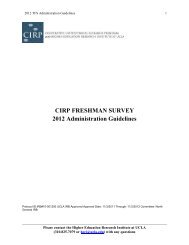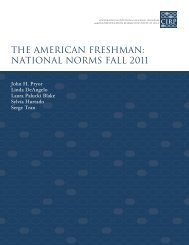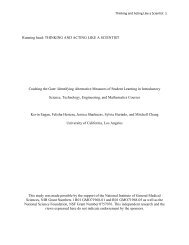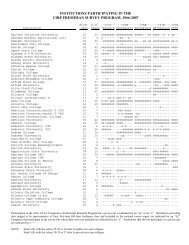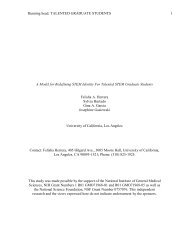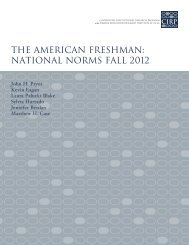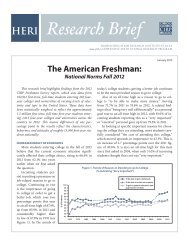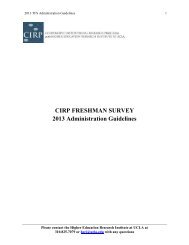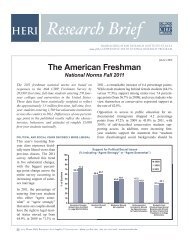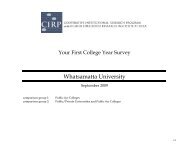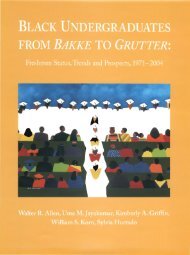North Dakota University System - Higher Education Research Institute
North Dakota University System - Higher Education Research Institute
North Dakota University System - Higher Education Research Institute
Create successful ePaper yourself
Turn your PDF publications into a flip-book with our unique Google optimized e-Paper software.
The ages of <strong>North</strong> <strong>Dakota</strong> faculty adhered to the national percentages consistently. The majority<br />
of two-year faculty members in the <strong>North</strong> <strong>Dakota</strong> <strong>University</strong> <strong>System</strong> were younger than their<br />
counterparts in four-year and doctorate-granting institutions. A significant majority of all<br />
respondents from all eleven campuses were White/Caucasian. Generally, NDUS institutions<br />
recorded lower percentages than their peers nationally in reporting diverse racial backgrounds.<br />
With a high of 99.4 percent to a low of 84.8 percent, <strong>North</strong> <strong>Dakota</strong> faculty overwhelmingly<br />
denoted teaching as their principal activity. These <strong>North</strong> <strong>Dakota</strong> percentages were higher than<br />
the national percentages for similar institutions. As a result, doctorate institutions in <strong>North</strong><br />
<strong>Dakota</strong> also reported lower percentages for research than their peers nationally.<br />
Not only was teaching the principal activity for the majority of all <strong>North</strong> <strong>Dakota</strong> faculty, but it<br />
was also their primary job interest. Percentages ranged from a high of 96.7 percent to a low of<br />
70.7 percent. NDUS two-year institutions recorded the highest percentages, while doctorategranting<br />
institutions reported the lower. Still, the <strong>North</strong> <strong>Dakota</strong> percentages were higher than the<br />
national percentages.<br />
A typical faculty member in a <strong>North</strong> <strong>Dakota</strong> doctoral institution spent 51.6 hours a week on jobrelated<br />
activities. For four-year institutions, the average number of hours was 53.2, and faculty<br />
at two-year institutions reported 54.0 hours per week. <strong>North</strong> <strong>Dakota</strong> faculty dedicated more<br />
hours per week to their positions than their peers nationally, and they spent the majority of their<br />
time on teaching, including preparation and advising. Again, these figures were greater than the<br />
national ones. For those NDUS faculty who spent less time teaching, more time was devoted to<br />
research and creative activities.<br />
The professional activities of <strong>North</strong> <strong>Dakota</strong> faculty patterned national trends and most of the<br />
publications occurred at the doctorate-granting institutions. However, exhibitions and<br />
performances were most often presented by faculty from four-year institutions. Overall, as<br />
stated earlier, <strong>North</strong> <strong>Dakota</strong> faculty generally published and performed less than their peers<br />
nationally as the time required for those activities was dedicated to teaching.<br />
Eight questions about faculty members’ use of technology were new to this survey. The<br />
percentages indicated that communicating by e-mail and writing memos or letters were the<br />
activities <strong>North</strong> <strong>Dakota</strong> faculty did most often in using the computer. NDUS faculty from all<br />
three types of institutions recorded lower percentages than the national norms in using computers<br />
to work from home. Low percentages were also reported for using the computer to participate in<br />
on-line discussions.<br />
Consistent with the amount of time <strong>North</strong> <strong>Dakota</strong> faculty spent on teaching, the personal goal<br />
noted by all respondents as most important or essential was to be a good teacher. Second in<br />
importance for all faculty was to be a good colleague. Of least importance to all respondents was<br />
the goal of influencing the political structure. These percentages reflected the national<br />
percentages.<br />
While the reason most <strong>North</strong> <strong>Dakota</strong> faculty chose a career in higher education was for the<br />
intellectual challenge, opportunities to teach was included among the top three reasons. This<br />
reinforces <strong>North</strong> <strong>Dakota</strong>’s faculty who viewed themselves foremost as teachers. Choosing to be<br />
a college professor for reasons of prestige and status was least indicated.<br />
19



